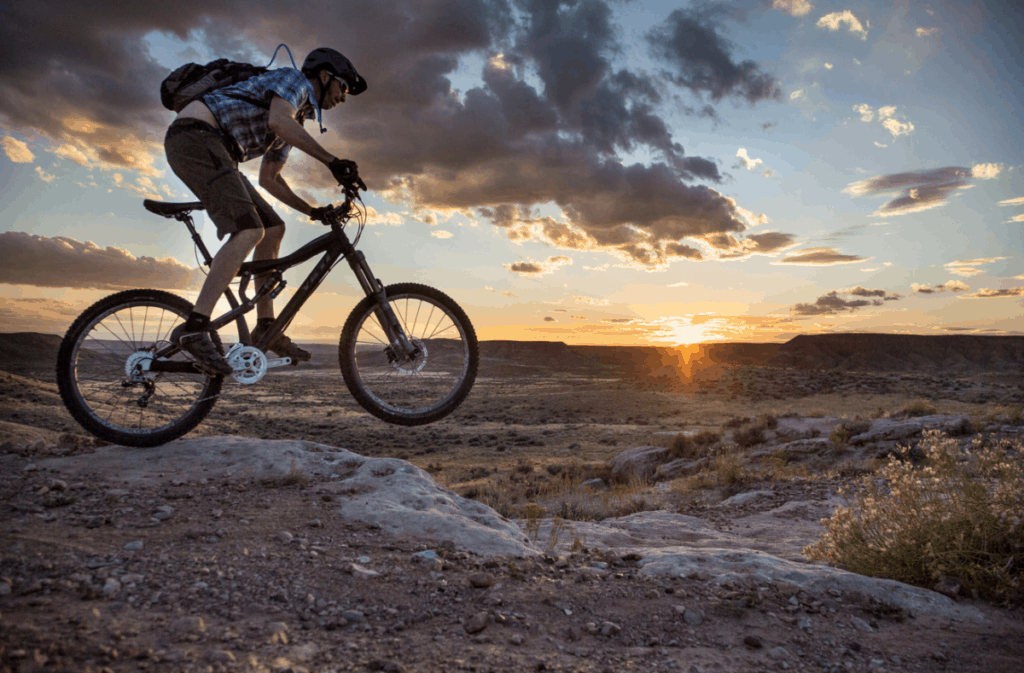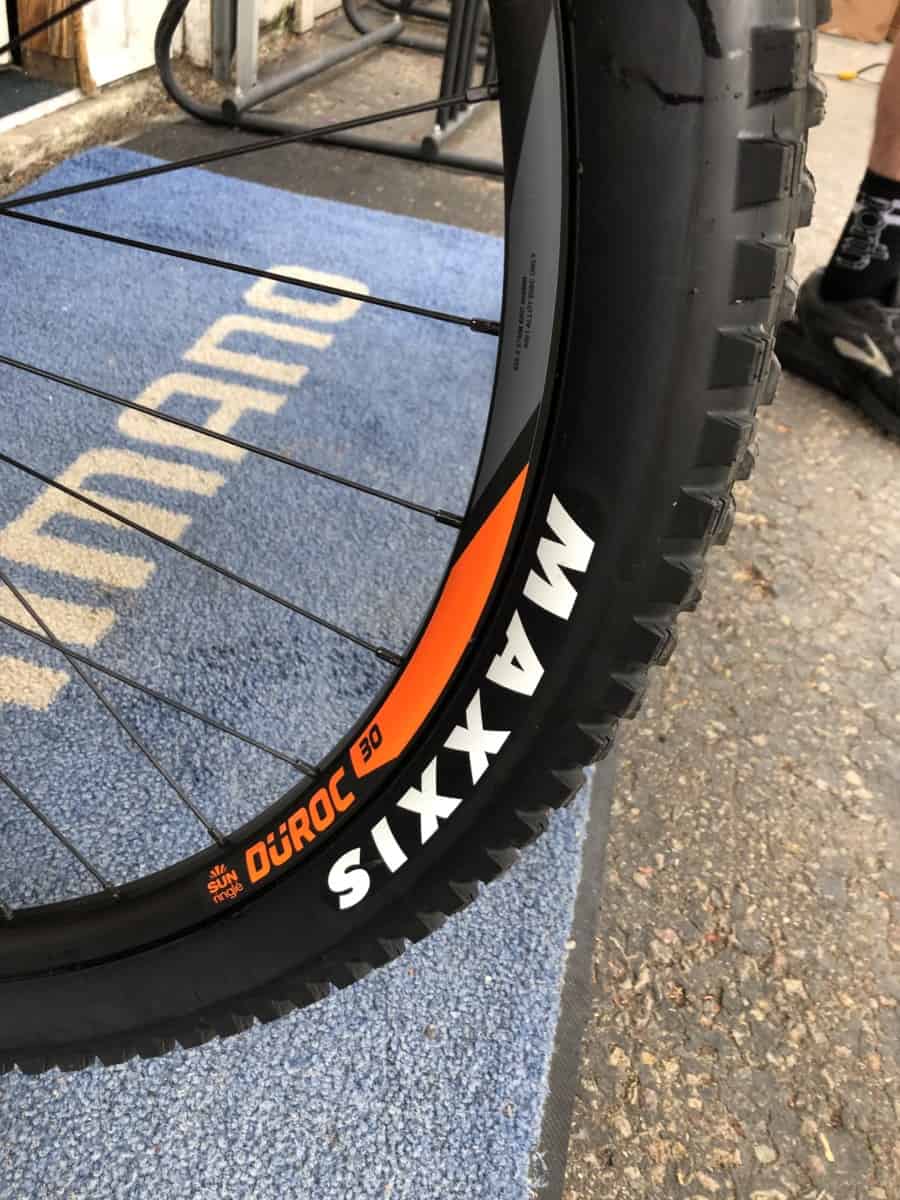When you are trying to have the best ride possible on your mountain bike out on the trails, one of the most important things for you to take into consideration is the tire pressure you have. There are a number of factors to take into consideration which can affect the pressure you should go with, so knowing what these factors are is definitely something you should learn.
As a general rule, for most tires your tire pressure should be around 20 to 30 psi. But some mountain bikers go as low as 10 psi or as high as 50 psi for different occasions and styles of riding.
In case you are wondering, PSI stands for pounds per square inch and this is the amount of pressure that the air inside is pushing against the inside of the tire. The more force it exerts, the more it pushes on the inside of the tire, and the harder the tire will feel.
Part of what determines the tire pressure that you should go with is a matter of personal preference, but there are some key signs that you can look for that will tell you if your tire pressure is too low or too high.
Signs Your Tire Pressure May Not Be Right For You
While expert mountain bikers can often tell just by giving the tire a squeeze if the pressure is right or not, the average person will have no clue about how to do that. While that is a skill that can come with practice and experience, there are some signs that you should be able to notice even if you are new to mountain biking.

Tire Pressure That Is Too High
One of the more obvious signs that your tire pressure is too high for you is a certain “bounciness” when you are going over the bumpy parts of a trail. As mentioned, the higher the psi is the harder the tire will feel.
When this hard tire hits the ground, it will bounce back up like a tight basketball will. However, while that is a good thing for basketballs to have that high of a psi, it is not good for mountain biking. This bouncing will not only wear you out faster, but it also means that you will have less control over your bike.
In order to turn your bike or direct it at all your bike tires have to be able to grip the ground. They cannot do this if your tire is in the air since your tires have to actually be touching the ground in order to grip it.
For this reason, in addition to noticing that your mountain bike is bouncing more, you will also likely notice that you are not getting the amount of grip that you need. This is something that can be potentially dangerous if you are riding fast.
The faster you are going, the harder you will hit those bumps and the higher you will bounce off of those bumps. If you happen to need to turn at this point you may not be able to do so at all and may find yourself going straight into a tree.
Tire Pressure That Is Too Low
While there are certain consequences to having tire pressure that is too high, there are other consequences to having tire pressure that is too low. The first one of these is that you have to work harder, particularly when you start pedaling.
This is because a tire that does not have enough pressure in it is so flat that it has no bounce to it at all. Instead of rolling over things in the path like it should, your tire is gripping them. While this does give you great traction and allows you to turn really well, it also slows you down by having practically no rolling resistance.
This can take its toll on your endurance quite quickly as you have to pedal harder to make up for the low tire pressure. If you like going fast or are just wanting to have fun, then you should definitely avoid this end of the psi spectrum.
Factors To Consider When Finding The Right Pressure For You
The right psi for you will always be one that is not too high and not too low and is just right. There are some things that you can keep in mind to help you find your goldilocks tire pressure, and experimentation is the key to finding your perfect psi.
Personal Preference
As mentioned, there are some clear signs that your tire pressure is too high or too low, but there is quite a bit of give and take when it comes to deciding if you want your tire pressure to be higher or lower. For example, a lower tire pressure will have a better grip while a higher tire pressure will let you go faster.
Which of these is more important to you is something that only you can decide for yourself. If you do not know which of these you prefer, the best choice would be to start somewhere in the middle and then either raise or lower it as you feel that you need to.
The Terrain
This is also something that is very important for you to take into consideration. If the terrain is fairly flat then you will likely want a higher psi since this will let you go as far as possible with as little energy as possible.
On the other hand, if the ground is bumpy you will not appreciate the bounce of the higher pressure and will also need the better grip that a lower tire pressure will give you. When you are going over bumpy terrain, this will actually help you to go faster.
This is especially true if the terrain you are riding on is wet, slipper, or is made of loose soil like sand or snow. You will need all the grip you can get in these situations and so will want your psi to be slightly lower than you would otherwise have it.
Weight And Width
I put these two together because of the fact that these are intertwined with each other. The more weight you are putting on your bike, whether you simply weigh a lot or you are going bikepacking and have bags on your bike, then the more air pressure you will need.
This is because the weight on the bike will press the rims further down to the ground. To counteract this you will need more air pressure in your tires to push your rims back up against this weight and keep your rims from hitting things.
The width of your tire plays a part in this as well since the wider the tire is the larger the area is that your weight is spread out on. This means that with wider tires you do not have to have nearly as much psi as you would with a thinner tire even if you weigh more.
Conclusion
While it is important to try to keep all of these things in mind when deciding what tire pressure is right for you and your mountain bike, it is equally important that you don’t forget to factor in the tire itself. Tires are made with a psi rating that determines what psi they are meant to have.
Since you do not want to go either above or below the recommended psi for a tire, you should try to find out this information. It can be dangerous to ride with a tire pressure that is too high for the tire and can result in the tire literally bursting underneath you while you are on the trail.
Another thing that you never want to do is to use an air compressor to inflate the tire on your mountain bike. While this is something that can be used in a pinch, they can easily overinflate the tire to the point where it literally explodes so it is not advisable to use it.

